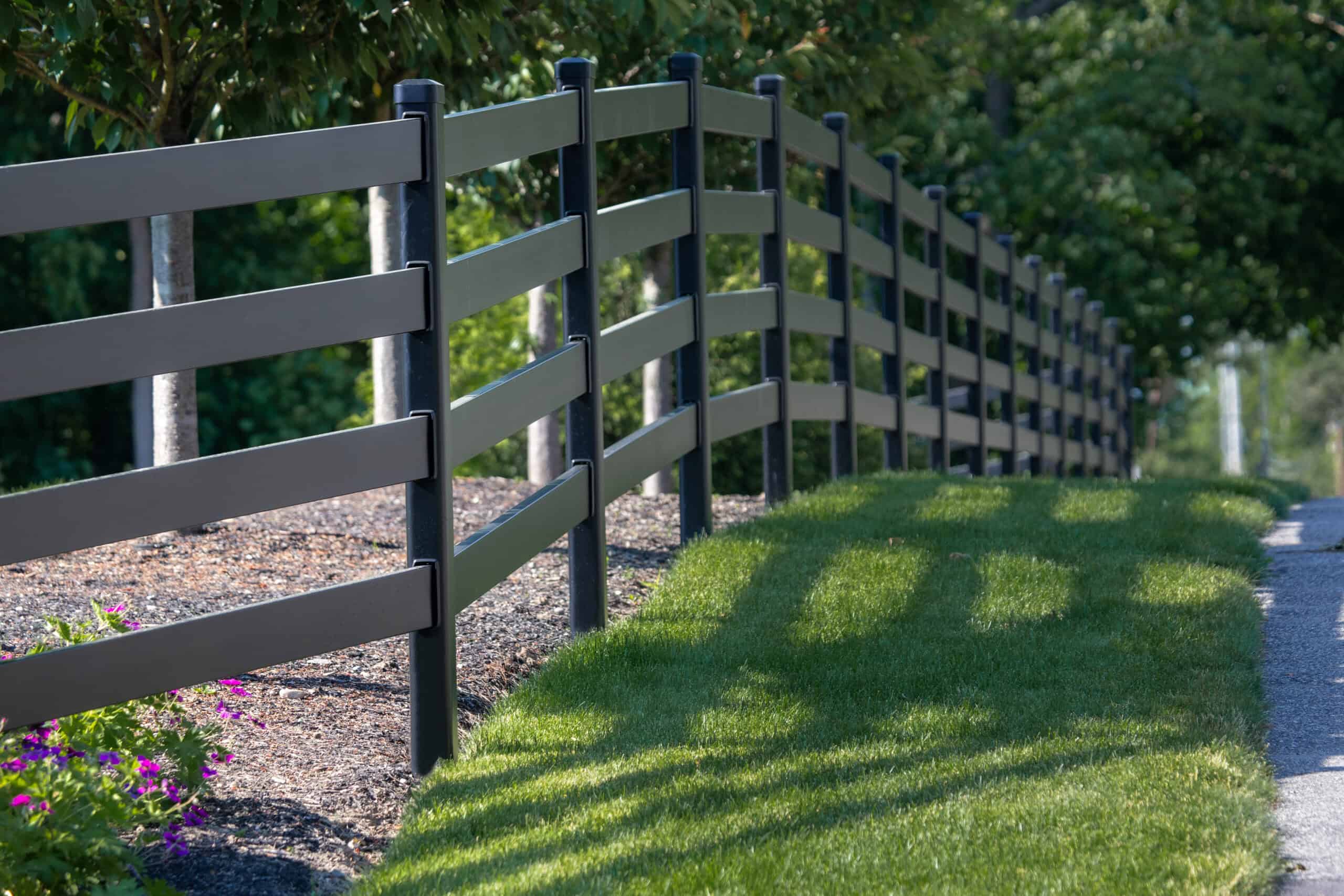Anyone who’s invested in horses knows they’re more than just livestock…they’re athletes, companions, and (almost always) a financial investment. When it comes to keeping these animals safe, your fencing choices matter more than most people realize.
Field fence (that standard agricultural fencing with graduated rectangular openings) might seem like an economical choice at first glance, but we’ve seen firsthand what happens when this common fencing material meets the unique challenges of containing horses.
The truth is that field fence was designed primarily for cattle and smaller livestock, not for the specific behaviors and physical attributes of horses. The consequences of cutting corners on horse fencing aren’t theoretical: they’re measured in veterinary bills, injured animals, and sleepless nights wondering if your horses are secure.
We’ve helped countless ranchers and horse owners recover from the false economy of inappropriate fencing. Field fence simply doesn’t provide the safety, durability, or peace of mind that responsible horse owners need. Below, we’ll break down exactly why field fence falls short for equines, and what you should be considering.
What Is Field Fence?
Field fence (sometimes called woven wire fence) is a standard agricultural fencing material consisting of horizontal and vertical wires woven together to create a mesh pattern with rectangular openings. These openings are typically graduated in size (smaller at the bottom, larger toward the top) primarily for containing sheep, goats, and cattle. It’s commonly made from galvanized steel wire in various gauges, with 14-gauge and 12.5-gauge being typical for farm applications.
Issues When It Comes to Horses
The problem starts with simple physics. Your average adult horse weighs between 900-1,500 pounds and can exert several thousand pounds of force when leaning, rubbing, or pushing against fencing. Field fence wasn’t engineered for this level of consistent pressure.
When a horse leans against field fence—something they do instinctively when grazing near boundaries—the woven wire begins to stretch and deform. Unlike purpose-built horse fencing that’s designed to withstand 2,000+ pounds of pressure, standard field fence begins to fail at much lower thresholds.
Even when properly installed (which requires significant tension), field fence loses its rigidity relatively quickly around horses. The connection points where horizontal and vertical wires meet begin to slip. Once this happens, the rectangular openings widen and create potential trap points for hooves.
The elements take a severe toll on field fence when horses are involved. During winter freeze-thaw cycles, the ground shifts and moves fence posts, causing field fence to sag dramatically. Heavy snow loads push it down, and horses quickly learn to walk right over these compromised sections. Hot summer temperatures cause expansion and contraction that further weakens connection points.
Why Field Fence Isn’t Safe for Horses
The safety risks field fence poses to horses extend far beyond simple containment issues. In our decades working with horse properties, we’ve seen firsthand how this inappropriate fencing choice can lead to serious injuries and even fatal accidents.
Entanglement Risks Unique to Equines
Horses frequently explore fencing with their muzzles and legs. Field fence’s loose wire design creates several catch points where a horse can get a halter, blanket, or even mane and tail hair entangled. When a horse panics (which they will when trapped), they’ll fight against the entanglement with their full strength. And that’s when things get messy.
Hoof and Leg Trap Scenarios
The graduated openings in field fencing create perfect traps for a horse’s hooves and legs. As horses paw at the ground near fencing (a common behavior), their hooves can slip through these openings.
When the horse tries to pull back, the hoof often won’t slide back through as easily. In panic, horses will pull with tremendous force, causing severe lacerations, tendon damage, and even broken bones.
Panel Separation Dangers
Field fence attaches to posts using staples or clips that simply weren’t designed to withstand a horse’s persistent pressure. As horses rub against fencing (which they do constantly), these attachment points begin to fail. The resulting separated sections create dangerous projections that can tear into a horse’s hide or create pockets where horses can get trapped between the fence and post.
Sharp Edge Concerns As Fence Ages
Even when new, field fence has wire ends that can be problematic. As it ages, exposed wire ends from breaks become increasingly dangerous. The galvanized coating wears off over time, leaving rusted, jagged edges that can cause tetanus-prone puncture wounds. Unlike smooth-wire horse fencing options, these sharp points create constant hazard zones around your property.
The False Economy Surrounding Field Fencing
When ranch owners come to us after a field fence failure, they often admit the same thing: “I thought I was saving money.” Don’t worry…you’re not alone.
This is the most expensive misconception in horse fencing.
Sure, field fence might save you $1-2 per foot on materials initially compared to proper horse fencing. On a 5-acre property, that might look like a $3,000-6,000 upfront savings. Sounds substantial until you factor in what comes next.
Field fence around horses typically needs partial replacement every 3-5 years and complete replacement by year 10. Proper horse fencing, meanwhile, often carries 20+ year warranties and frequently lasts 30+ years with minimal maintenance.
When you factor in multiple replacements plus ongoing repairs, that initial “savings” evaporates quickly.
Plus, we consistently see field fence requiring repair work at least twice annually when horses are involved. Every broken section, sagged panel, or compromised post represents not just materials, but your valuable time or contractor expenses. Quality horse fencing might need attention once every several years (if that).
The labor savings alone justify the initial investment, not to mention the reduced headaches from emergency repairs when you discover your horses have damaged another section.
Professional horse property appraisers consistently note that appropriate fencing impacts resale value. When potential buyers walk your property, inappropriate fencing like field fence immediately signals “amateur operation” and raises red flags about what other corners might have been cut.
We’ve seen proper horse fencing return 100-150% of its installation cost when properties sell, while field fence actually detracts from property values as potential buyers mentally calculate replacement costs.
Better Fence Options for Horse Owners
The right fencing for horses is about containment, safety, durability, and long-term peace of mind. Here are a few of the best alternatives that consistently perform well for equine applications.
| Fence Type | Safety Rating | Durability | Maintenance | Initial Cost | Lifetime Value |
| Steel Board | Excellent | 30+ years | Minimal | $$$$ | Excellent |
| PVC/Vinyl | Very Good | 20+ years | Low | $$$ | Good |
| Wood Rail | Good | 7-15 years | High | $$$ | Fair |
| High-Tensile Wire | Good | 20+ years | Moderate | $$ | Good |
| Electric Tape/Rope | Fair | 5-10 years | High | $ | Poor |
| Coated Wire Mesh | Very Good | 25+ years | Low | $$$ | Very Good |
Fence Options
- Steel Board Fencing combines the classic appearance of wood with unmatched durability and safety. These systems feature horizontal steel rails with flexible connections that prevent horse injuries while standing up to decades of use without warping, splintering, or requiring painting.
- PVC/Vinyl Fencing offers visible white boundaries that horses respect, with smooth surfaces that minimize injury risk. While susceptible to extreme temperature variations and potentially brittle in very cold climates, quality vinyl systems provide 20+ years of relatively maintenance-free service.
- Wood Rail Fencing provides the traditional aesthetic many horse owners prefer, but requires ongoing maintenance. Regular painting/staining, board replacement, and checking for protruding nails makes this a higher-maintenance option that typically needs complete replacement within 15 years.
- High-Tensile Wire uses strong, smooth wires (usually 12.5 gauge or heavier) under significant tension, which makes it more forgiving than field fence if a horse runs into it. When properly installed with appropriate visibility enhancements, this can be a cost-effective solution for larger properties.
- Electric Tape/Rope offers highly visible boundaries with the deterrent of mild electrical shock, making it suitable for temporary arrangements or rotational grazing. However, it requires constant monitoring, has limited physical stopping power, and depends on consistent electrical current to be effective.
- Coated Wire Mesh features heavy gauge wire with specialized coatings that prevent injuries and resist corrosion. When manufactured specifically for horses (not repurposed from other applications), these systems provide excellent containment while eliminating most entanglement risks.
Keeping Your Horses Safe Today and Tomorrow
Ultimately, cutting corners on fencing always costs more in the end. Field fence might seem like an acceptable solution until that first injury occurs or until you’re spending another weekend repairing sagging sections while your riding time disappears.
Your horses deserve boundaries that keep them secure without becoming hazards themselves. Quality horse fencing isn’t an expense—it’s protection for everything else you’ve invested in your equine partners.
Don’t wait for the inevitable problems field fence brings. Contact us today for a no-obligation consultation about creating safer boundaries for your horses. Whether you’re ready to fence your entire property or just beginning to explore options beyond field fence, we’re here to help you protect what matters most.



